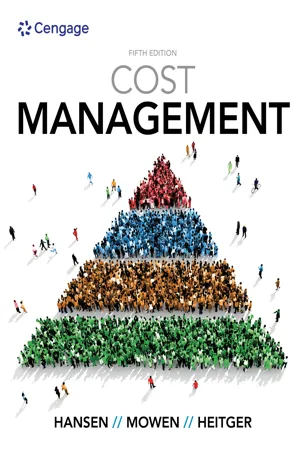Business
NPV vs IRR
NPV (Net Present Value) and IRR (Internal Rate of Return) are both financial metrics used to evaluate the profitability of an investment. NPV calculates the present value of future cash flows, while IRR represents the discount rate that makes the net present value of an investment zero. NPV is used to determine the absolute value of an investment, while IRR indicates the potential return on investment.
Written by Perlego with AI-assistance
Related key terms
1 of 5
12 Key excerpts on "NPV vs IRR"
- eBook - PDF
ACCA Financial Management
Practice and Revision Kit
- BPP Learning Media(Author)
- 2021(Publication Date)
- BPP Learning Media(Publisher)
166 Financial Management (FM) (b) In most simple accept or reject decisions, IRR and NPV will select the same project. However, NPV has certain advantages over IRR as an investment appraisal technique. NPV and shareholder wealth The NPV of a proposed project, if calculated at an appropriate cost of capital, is equal to the increase in shareholder wealth which the project offers. In this way NPV is directly linked to the assumed financial objective of the company, the maximisation of shareholder wealth. IRR calculates the rate of return on projects, and although this can show the attractiveness of the project to shareholders, it does not measure the absolute increase in wealth which the project offers. Absolute measure NPV looks at absolute increases in wealth and thus can be used to compare projects of different sizes. IRR looks at relative rates of return and in doing so ignores the relative size of the compared investment projects. Non-conventional cash flows In situations involving multiple reversals in project cash flows, it is possible that the IRR method may produce multiple IRRs (that is, there can be more than one interest rate which would produce an NPV of zero). If decision-makers are aware of the existence of multiple IRRs, it is still possible for them to make the correct decision using IRR, but if unaware they could make the wrong decision. Mutually-exclusive projects In situations of mutually-exclusive projects, it is possible that the IRR method will (incorrectly) rank projects in a different order to the NPV method. This is due to the inbuilt reinvestment assumption of the IRR method. The IRR method assumes that any net cash inflows generated during the life of the project will be reinvested at the project's IRR. NPV on the other hand assumes a reinvestment rate equal to the cost of capital. Generally NPV's assumed reinvestment rate is more realistic and hence it ranks projects correctly. - eBook - ePub
Making the Compelling Business Case
Decision-Making Techniques for Successful Business Growth
- W. Messner(Author)
- 2013(Publication Date)
- Palgrave Macmillan(Publisher)
Hence the IRR rule calls for the acceptance of business cases if their IRR is greater than the opportunity cost of capital. Many finance departments prefer the IRR rule to the NPV method. While mathematically both formulas are equivalent, the IRR method can be outright dangerous if not presented properly. In order to understand why one should always (!) use the much safer NPV method in business cases instead of the IRR rule, the following looks at four investment scenarios which are pitfalls in a sense that they directly lead to the wrong investment decision if their IRRs are blindly compared.Trap 1: Borrowing instead of investing
Not all projects necessarily have NPVs that decline as the opportunity cost of capital goes up. For instance, if one hurriedly compares the two projects A and B in Figure 2.10 , one might be tempted to think that they are equally attractive investments, as each one of them has an IRR of 6.38 per cent.So, where is the difference? Project A is the typical investment project discussed many times in this book; there is a cash outflow in period 0 followed by cash inflows in the subsequent periods. The NPV of project A therefore decreases as the discount rate is being raised. Project B, on the contrary, has an NPV which goes up as the discount rate is brought down. The company borrows money (cash inflow in period 0) and returns it over subsequent periods as cash outflows; it thus looks for a low rate of return. But when one invests (or lends) money, one looks for a high rate of return.Figure 2.10 IRR Trap 1: Borrowing in period 0When using the IRR method, one first needs to establish whether the investment project under scrutiny is about investing or borrowing as this determines whether a higher IRR or a lower IRR is desirable. While this is easy to make out from the simple cash flows in Figure 2.10 - eBook - PDF
- Robert Parrino, David S. Kidwell, Thomas Bates(Authors)
- 2016(Publication Date)
- Wiley(Publisher)
The following table shows the NPVs for the two projects at several discount rates: Discount Rate NPV of Project A NPV of Project B 0% €50.0 €65.0 5% 34.5 42.9 10% 21.5 24.9 13% 14.8 15.7 15% 10.6 10.1 20% 1.3 − 2.2 25% − 6.8 − 12.6 30% − 13.7 − 21.3 IRR 20.7% 19.0% Notice that the project with the higher NPV depends on what rate of return is used to discount the cash flows. Our example shows a conflict in ranking order between the IRR and NPV methods at discount rates between 0 and 13 per cent. In this range, project B has the lower IRR but it has the higher NPV and should be the project selected. If the discount rate is above 15 per cent, however, project A has the higher NPV as well as the higher IRR. In this range, there is no conflict between the two evaluation methods. Now take a look at Exhibit 10.11, which shows the NPV profiles for projects A and B. As you can see, there is a point, called the crossover point , at which the NPV profiles for projects A and B intersect. The crossover point here is at a discount rate of 14.3 per cent. For any cost of capital above 14.3 per cent, the NPV for project A is higher than that for project B; thus, project A should be selected if its NPV is positive. For any cost of capital below the crossover point, project B should be selected. Another conflict involving mutually exclusive projects concerns comparisons of projects that have significantly different costs. The IRR does not adjust for these differences in size. What the IRR gives us is a rate of return on each unit of currency invested. In contrast, the NPV method computes the total monetary value created by the project. The difference in results can be sig-nificant, as can be seen in Decision-Making Example 10.2. crossover point The discount rate at which the NPV profiles of two projects cross and, thus, at which the NPVs of the projects are equal. - eBook - PDF
- Don Hansen, Maryanne Mowen, Dan Heitger, , Don Hansen, Maryanne Mowen, Dan Heitger(Authors)
- 2021(Publication Date)
- Cengage Learning EMEA(Publisher)
Editorial review has deemed that any suppressed content does not materially affect the overall learning experience. Cengage Learning reserves the right to remove additional content at any time if subsequent rights restrictions require it. Chapter 19 Capital Investment 983 decisions in the presence of competing alternatives. In reality, it can be shown that the NPV model is generally preferred to the IRR model when choosing among mutually exclusive alternatives. NPV Compared with IRR NPV and IRR both yield the same decision for independent projects. For example, if the NPV is greater than zero, then the IRR is also greater than the required rate of return; both models signal the correct decision. For competing projects, however, the two methods can produce different results. Intuitively, we believe that, for mutually exclusive projects, the project with the highest NPV or the highest IRR should be chosen. Since it is possible for the two methods to produce different rankings of mutually exclusive projects, the method that consistently reveals the wealth-maximizing project should be preferred. As will be shown, the NPV method is that model. NPV differs from IRR in two major ways. First, NPV assumes that each cash inf low received is reinvested at the required rate of return, whereas the IRR method assumes that each cash inf low is reinvested at the computed IRR. Second, the NPV method measures profitabil-ity in absolute terms, whereas the IRR method measures it in relative terms. Because NPV is measured in absolute terms, it is affected by the size of the investment, whereas IRR is size inde-pendent. For example, an investment of $100,000 that produces a cash f low one year from now of $121,000 has the same IRR (21 percent) as an investment of $10,000 that produces a cash f low one year from now of $12,100. Note, however, that the NPV is $10,000 for the first invest-ment and $1,000 for the second. - No longer available |Learn more
- Don Hansen, Maryanne Mowen(Authors)
- 2017(Publication Date)
- Cengage Learning EMEA(Publisher)
Chapter 19 Capital Investment 1021 3. Calculate the net present value (NPV) for independent projects. • NPV is the difference between the present value of future cash fl ows and the initial invest-ment outlay. • To use the model, a required rate of return must be identi fi ed (usually, the cost of capital). The required rate of return is used to calculate the present value of future cash fl ows. • If the NPV > 0, then the investment is acceptable. 4. Compute the internal rate of return (IRR) for independent projects. • The IRR is computed by fi nding the interest rate that equates the present value of a proj-ect ’ s cash in fl ows with the present value of its cash out fl ows. • If IRR is greater than the cost of capital, then the investment is acceptable. 5. Tell why NPV is better than IRR for choosing among mutually exclusive projects. • NPV measures the increase in a fi rm ’ s wealth caused by a project. Thus, choosing the pro-ject that increases wealth the most makes sense. • IRR sometimes will signal that one project is better than a second, even though the second increases wealth more. • NPV consistently provides the correct signal when choosing among competing projects and is preferred to IRR. 6. Convert gross cash fl ows to after-tax cash fl ows. • Accurate and reliable cash fl ow forecasts are absolutely critical for capital budgeting analyses. • All cash fl ows in a capital investment analysis should be after-tax cash fl ows. • There are two different, but equivalent, ways to compute after-tax cash fl ows: the income method and the decomposition method. • Although depreciation is not a cash fl ow, it does have cash fl ow implications because tax laws allow depreciation to be deducted in computing taxable income. • Accelerated methods of depreciation are preferred because of the tax bene fi ts created. 7. Describe capital investment for advanced technology and environmental impact settings. - eBook - PDF
- Scott Besley, Eugene Brigham, Scott Besley(Authors)
- 2021(Publication Date)
- Cengage Learning EMEA(Publisher)
In making the ac- cept/reject decision, most large, sophisticated firms, such as IBM, General Electric, and General Motors, calculate and consider multiple measures because each provides decision makers with a somewhat different piece of relevant information. Traditional payback and discounted payback provide information about both the risk and the liquidity of a project. A long payback means (1) the investment dollars will be locked up for many years, hence the project is relatively illiquid; and (2) the project’s cash flows must be forecast far out into the future, hence the project is probably quite risky. 10 A good analogy for this is the bond valuation process. An investor should never compare the yields to maturity on two bonds without considering their terms to ma- turity, because a bond’s riskiness is influenced by its maturity. NPV is important because it gives a direct mea- sure of the dollar benefit (on a present value basis) to the firm’s shareholders, so we regard NPV as the best single measure of profitability. IRR also measures profitability, but here it is expressed as a percentage rate of return, which many decision makers, especially nonfinancial managers, seem to prefer. Further, IRR contains information concerning a project’s “safety margin,” which is not inherent in NPV. To illustrate, consider the following two projects: Project T costs $10,000 at t 5 0 and is expected to return $16,500 at the end of one year, while Project B costs $100,000 and has an expected payoff of $115,500 after one year. At a 10 percent required rate of return, both projects have an NPV of $5,000, so by the NPV rule we should be indifferent between the two. However, Project T actually provides a much larger margin for er- ror. Even if its realized cash inflow turns out to be almost 40 percent below the $16,500 fore- cast, the firm will still recover its $10,000 investment. - eBook - ePub
Capital Budgeting Valuation
Financial Analysis for Today's Investment Projects
- H. Kent Baker, Philip English, H. Kent Baker, Philip English(Authors)
- 2011(Publication Date)
- Wiley(Publisher)
The dominance of NPV as a project evaluation method among academics does not appear to be shared by practitioners who often prefer to use IRR and the seemingly inferior PB measure. The use of PB appears to be a combination of focus on short-term liquidity needs (with or without an agency issue) and a cost-benefit analysis relative to project evaluation. In other words, safe or lesser valued projects do not warrant extensive analysis and are not good candidates for a NPV analysis.The popularity of IRR is more puzzling in that it is an imprecise rate of return metric. For instance, having an IRR of 13 percent versus an appropriate risk-adjusted return of 10 percent does not imply a gain of three percentage points. Consequently, the interpretation that people often assign to the IRR is incorrect because the percentage point gain can only be obtained if intermediate cash flows can appreciate at the IRR throughout the project's life. This “problem” became known as the “reinvestment problem,” which led to much research to better define the issue and to potentially mitigate the problem by calculating MIRR.MIRR is consistent with NPV because the NPV calculation is actually within the MIRR calculation. This equivalence can be seen by evaluating the MIRR calculation in terms of the PI, which is an NPV calculation in a ratio format. PI is generally not as useful as the NPV calculation, but PI does have some benefits when evaluating acceptable projects under a capital constraint.In general, all of these metrics are related in some fashion. IRR is the discount rate that sets NPV to zero, PI to one, and DPB and PBL to the duration of the project. An NPV > 0 implies that the project life is greater than PB, DPB, and PBL, PI > 1, and MIRR > cost of capital (or a hurdle rate). An NPV < 0 implies that the project life is less than DPB and PBL, PI < 1, and MIRR < cost of capital (or a hurdle rate). Being able to see these relationships allows the decision maker to use more than one metric, convert a given metric into another, and understand the biases of each metric. Ultimately, the decision maker should realize that these project evaluation techniques are simply tools to help in the decision-making process. All of the considerations necessary for making the decision are not contained within any one of these metrics alone or combined. - eBook - PDF
Profit Planning
For hospitality and tourism (extended edition)
- Peter Harris(Author)
- 2013(Publication Date)
- Goodfellow Publishers(Publisher)
We can see the IRR ranking determines our choice to be Project B because it has the higher internal rate of return of 31% compared to Project A, which has a rate of return of 25%. Thus, use of the NPV method at 10% and the IRR method for ranking projects can provide conflicting results. The reason for this is the NPV method assumes 14: Capital expenditure decisions 213 the cash inflows are reinvested at the rate used to discount, in this case 10%. By comparison, the IRR method assumes the cash flows are reinvested at the IRR rate, in this case 25% and 31% respectively for Projects A and B, which may prove to be an unrealistic assumption. Project A Project B DCF Total DCF Total Cash factor present Cash factor present Year inflow at 25% value inflow at 31% value £ £ £ £ 1 3,000 0.800 2,400 6,000 0.763 4,578 2 3,000 0.640 1,920 5,000 0.583 2,915 3 4,000 0.512 2,048 4,000 0.445 1,780 4 9,000 0.410 3,690 2,000 0.340 680 Present value of inflows 10,058 9,953 Initial outlay 10,000 10,000 £ 58 £ -47 Ranking per IRR (2) (1) Figure 14.6: Two mutually exclusive projects: Internal Rate of Return ranking Remember: the IRR method requires us to use the rate of interest (DCF factor) which will reduce the net present value of a project to zero. Note: The crucial test for accepting or rejecting capital projects depends on whether or not the IRR compares favourably with the rate of return required by a business. The NPV method is often considered to be the more suitable method since it uses the same discount rate for alternative proposals, and that rate will normally represent the hurdle rate – the minimum rate acceptable for capital expenditure projects in a particular business. Cost of capital Using discounted cash flow to assess capital projects requires the calculation of our cost of capital. So, let’s consider why this is the case. A business may obtain funds from a variety of sources, each of which has a different cost associated with it. - Martin Hopkinson(Author)
- 2017(Publication Date)
- Routledge(Publisher)
Internal rate of return IRR is a discounted financial modelling measure that is often used alongside or in place of NPV forecasts. IRR is defined as being the discount rate that would result in a project NPV of zero. It is possible to calculate IRR manually in very simple cases. Excel also has an IRR function. However, the usual procedure for obtaining IRR is to create an NPV model and use trial and error to determine the discount rate that results in an NPV that is sufficiently close to zero for the level of accuracy that is appropriate. As an example, the IRR for Model 2.2 is approximately 17%. A similar procedure can be employed with NPV risk models, using the mean NPV forecast equal to zero as the basis for obtaining the IRR.Organisations using IRR usually specify a hurdle rate for projects that must be exceeded in order for them to be approved. If this practice is intended to be consistent with the NPV rule, then the hurdle would be set at the relevant discount rate. However, organisations often choose to set a higher hurdle than this on the grounds of reluctance to accept the risk of proceeding with projects with business cases that are only marginal. Whilst this way of thinking is understandable, it can also be interpreted as being a form of blanket discount rate adjustment which, for reasons described earlier in this chapter, may have counterproductive effects.The advantage of IRR over NPV is that IRR is independent of project size. If, for example, you take any NPV model and double each cost and benefit input, you would double the NPV, but the IRR would remain constant. IRR can thus be a useful measure to report alongside NPV forecasts for large projects that appear to be attractive from an NPV perspective but are exposed as being marginal by their IRR.A perception that IRR provides a clearer comparison between projects than NPV is probably the most important cause of its widespread use. Unfortunately, the technique has limitations which, unless recognised, can lead to errors in project selection, particularly when relatively unusual cash flow patterns are involved. Brealey, Myers and Allen (2014) provide a good illustration of the types of circumstance in which the NPV and IRR measures can lead to contradictory evidence. Whereas NPV forecasts are based on today’s value of cash, and can thus be used as a rational basis for choice, IRR does not behave in a similarly consistent manner. A key conclusion from this is that IRR should not be used to choose between mutually exclusive options. When comparing different options for the same project the use of IRR would thus be incorrect.- eBook - ePub
Multiple Interest Rate Analysis
Theory and Applications
- M. Osborne(Author)
- 2014(Publication Date)
- Palgrave Pivot(Publisher)
et al . (2011) contains a classic statement of the arguments and lists four pitfalls.1 An IRR, by itself, does not indicate whether a project involves borrowing or lending;2 Some cash flows cause the IRR equation to solve for more than one plausible IRR, resulting in ambiguity about which IRR to use as a criterion;3 NPV and IRR do not always rank mutually exclusive projects the same; the consensus opinion is that ranking by NPV is reliable, and therefore ranking by IRR is not;4 A non-flat yield curve provides more than one cost of capital with which to compare IRR leading to uncertainty about which cost of capital to employ.Despite the pitfalls there is considerable empirical evidence that the majority of practitioners continue to use IRR as an investment criterion and performance measure. For example, in the context of capital budgeting there is the study of US data by Graham and Harvey (2001) and the similarly executed study of European data by Brounen et al . (2004). Many studies of capital budgeting practice are published every year containing similar results for various countries. In the context of IRR as a performance measure for private equity firms, hedge funds, and venture capitalists see the works by Phalippou (2008), Phalippou and Gottschalg (2009), Dichev and Yu (2011), and Achleitner et al. - eBook - PDF
Corporate Finance
Theory and Practice in Emerging Economies
- Sunil Mahajan(Author)
- 2020(Publication Date)
- Cambridge University Press(Publisher)
Other methods base the decision on cash flows. Moreover, the ARR method is based on book value and ignores the time value of money. However, accounting figures are readily available and thus ARR calculation becomes simple and straightforward. There is no need to convert accounting figures to cash flows. 120 | Corporate Finance More on NPV versus IRR Earlier in the chapter we have discussed the relative merits and demerits of the two methods. Here are a few more comments. 1. Multiple rates of return: Although not very common, there may be projects which have more than one IRR. As a simple illustration, let us take a project with the following cash flows. C 0 C 1 C 2 −100 230 −132 A return of 10 per cent as well as 20 per cent will make the NPV of the aforementioned cash flows equal to zero. The project can be said to have IRR of 10 per cent as well as 20 per cent. If the COC of the company is 14 per cent, we do not know whether to accept the project or reject it. Multiple IRRs can arise if there is more than one change in the cash flow signs during the life of the project, that is, negative cash flows changing to positive and vice versa. In the previous equation, we had an initial negative cash flow becoming a positive cash flow in the first year and changing a second time to negative cash flows in the second year. 2. Infeasible IRR: Sometimes the cash flows generated may not yield a feasible IRR. It is impossible to find a rate that will make the NPV of the cash flows equal to zero. The NPV of course can be easily determined. C 0 C 1 C 1,000 −3,000 2,500 These cash flows have no feasible IRR. However, at 10 per cent COC, the NPV can be quite easily determined to be 339. Mutually Exclusive Projects Until now, we have focused on a single project to decide whether the company should invest or not. We have relied on two methods, namely the NPV and the IRR for our decision. - eBook - ePub
Strategic Entrepreneurial Finance
From Value Creation to Realization
- Darek Klonowski(Author)
- 2014(Publication Date)
- Routledge(Publisher)
Table 10.6 show that Project B has a higher NPV than Project A ($81,308.0 versus $71,298.7) and that Project A has a higher IRR compared with Project B (47.2 percent versus 38.3 percent). The entrepreneurial firm is now faced with conflicting decision-making criteria based on the NPV and IRR methods. If the projects were independent (i.e., both could be selected), then there would be no problem, as both projects generate a positive NPV and the IRR exceeds the required rate of return equal to 15 percent. Assuming that the projects are mutually exclusive, the entrepreneurial firm has to choose one. In situations of conflict between IRR and NPV, the project with the highest NPV should be selected because NPV indicates the dollar amount of value that is purported to be added to the value of the firm as a result of undertaking the capital budgeting project. In our case, Project B would be selected because its NPV value exceeds that of Project A.Table 10.6 A summary of net present value (NPV) and internal rate of return (IRR) results for Project A and Project BProject A B NPV 71,298.7 81,308.0 IRR 47.2% 38.3% Strategic considerations and real options
Many entrepreneurial firms deal with multiple strategic concerns such as the purchase of assets, marketing expenditures, new product introductions, research and development (R&D) investments, acquisitions of other firms, mergers with other firms, or undertaking other initiatives. Many of these investment opportunities have unique characteristics in that they have choices (or options) embedded within them. This special characteristic of investment projects, where single or multiple revisions to the project are possible, is called a “real option” (please note that this type of option is not a derivative financial instrument). Real options are sometimes called “growth options” as growth opportunities are often among the most popular strategic considerations (other types of real options also exist). These options are called “real” because they often involve real assets such as land, buildings, equipment, or machinery; they do not, however, have to involve tangible assets (as observed earlier). Real options allow us to approach the problems of strategic choice and financial investment as a collection of interdependent decisions.The flexibility provided by a real option to revise a project at a later date has value. Real options allow for a number of options: to grow (expanding the scope of operations by introducing new products or services); to expand or contract (increasing or decreasing the scale of operations depending on market opportunity and demand); to defer (adopting a “wait-and-see” approach to take action until another time when information can be received in order to allow for better decision making); to abandon (discontinuing the project); to tranche (committing to investing in stages or tranches in order to give rise to further evaluation); to switch inputs (altering the mix of inputs in the production process); to create another project on the basis of the initial investment (giving rise to follow-up opportunities that firms may or may not ultimately exploit); or to do something else. Real options allow a firm the flexibility to adapt its decision-making process in response to the changing conditions of the external market. Many industries in which entrepreneurial firms participate are filled with uncertainty, change, and competitive dynamics; hence, an understanding of real options can be valuable to entrepreneurial firms. In short, entrepreneurial firms can generate value by identifying, managing, and executing their real options in relation to their anticipated investment projects.
Index pages curate the most relevant extracts from our library of academic textbooks. They’ve been created using an in-house natural language model (NLM), each adding context and meaning to key research topics.











